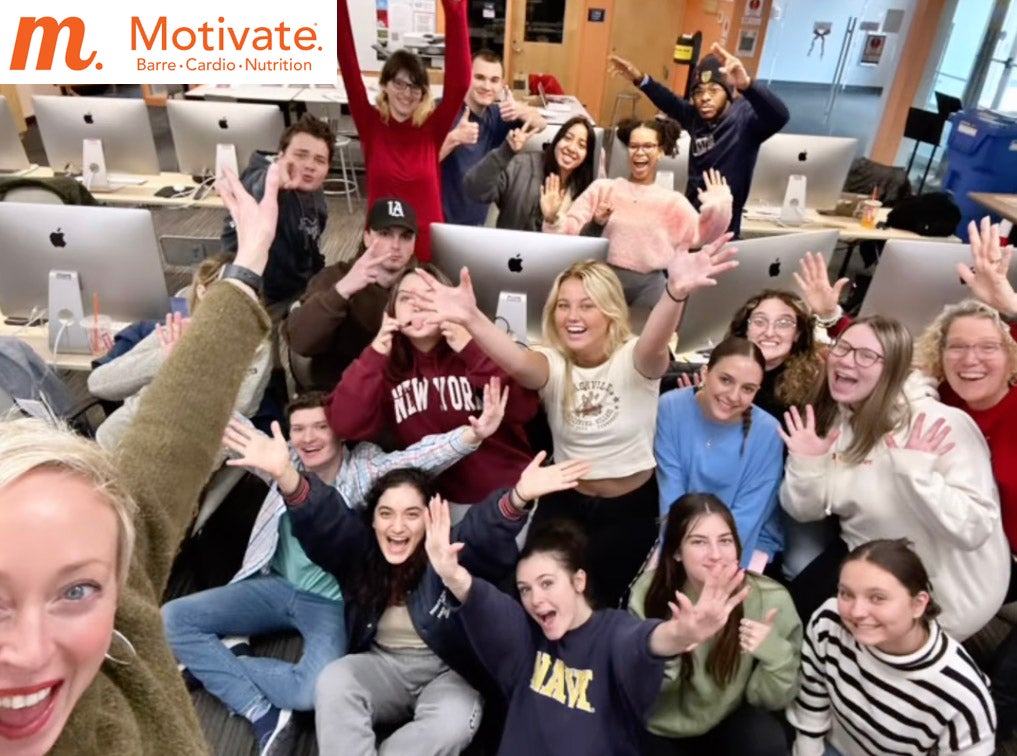Graphic design professors, Nancy Wynn and Dan Vlahos, regularly integrate real-world projects into their curriculum—from introductory to advanced courses engaging with on- or off-campus clients. These experiential learning opportunities provide students with challenging projects, as well as build their written and oral communication skills. Previous VPA news stories showcased the Austin Hall Chapel Banner project, the Mission Hill Arts Festival, the “Get Out to Vote 2020” AIGA Voting campaign, the ROVE app, and the Women’s Hockey East Championship Trophy design.
This important practice continues with ever more dynamic projects such as the Industrial History Center branding and website project; the Robert Frost Foundation branding project; the Rogers Center for the Arts banners; a poster design for the VPA theatre production of A Wrinkle in Time; and the Motivate Mural project.

The Industrial History Center is a new cultural center in Amesbury, MA. It brings the city’s past and present together with exhibitions, lectures, experiential events, and fundraising. Starting in 2021, John Mayer, the former Executive Director of the Amesbury Carriage Museum, led a fundraising and design effort to transform the ground level of a former mill factory (Mill 2) in Amesbury’s historic Upper Millyard into a lively history-focused community and exhibition space. Mayer’s vision was to make the “community a campus.” To facilitate this, the Center needed branding and a website. Though a brandmark was developed by a professional design company, implementing the brand across collateral experiences was the Graphic Design Studio III students’ charge. In the end, the students created a cohesive visual look for a website design, signage, promotional materials and stationery. The Industrial History Center officially opened to the public in October of 2021. At the project’s conclusion, Mayer remarked, “Beyond creating essential design materials, the design team really helped us understand and shape what this could be.” Professor Vlahos noted the multidisciplinary use of branding, experience, and environmental design—stating that, “one exciting facet of the project was this idea of elevating history within a community context and within a specific place.”
A similar project was completed for the Robert Frost Foundation in Lawrence, MA. Professor Vlahos integrated a branding project into the Graphic Design Studio II syllabus, leading to The Foundation receiving a visual brand they could apply to their presentation events, videos and promotional materials. Students and the outside client worked closely throughout the project, with Professor Vlahos facilitating the professional experience and development of the work.
On-campus projects are also valued at Merrimack College. Recently, the Rogers Center for the Arts was in need of updated promotional banners for their entrance. This project was integrated into the Graphic Design Studio II course, tasked with creating designs which visually represent the events taking place inside the Center. The final proposals were presented as a collaboration between all students in the class, with a lead student for each banner design. Alumnae Dani Castino ‘23, whose designs were ultimately selected, shares her experience, “seeing my work produced and representing the College was exciting—and my hope was that my solution truly embodied the richness of this vital campus resource as a whole—and the students who bring it to life.”

Additionally, the Theatre Arts program needed promotional materials for their performance of A Wrinkle in Time, which Professor Wynn integrated into the Visual Storytelling course. Twenty students worked on two ideas each for a total of forty designs that were presented to Professor Kathleen Sills. She noted, “The collaboration with the visual Storytelling students was extremely satisfying and generative. When I first came to work with them, they had prepared by reading the story and/or watching the film version. I was able to talk about my concept for our theatrical adaptation and they asked thought provoking questions. I was extremely impressed by their promotional designs. It was clear that they had taken in my point of view about the story and were able to emphasize that through their developing skills in creating visual imagery. They responded well to my feedback and the final poster designs showed that they were embracing the iterative nature of the design process. Through this assignment, the Visual Storytelling students became part of the larger team that worked to bring the production to life, thus expanding the interdisciplinary mission of the Department of Visual and Performing Arts. I hope that a similar collaboration can continue in the future.” Ben Abdou’s ‘25 design was chosen as the final concept, “This was a very fun challenge, as A Wrinkle in Time is an amazing book so to create a poster for its play counterpart was exciting. While the story’s imagery is out of this world it still maintains close-to-home themes of love and connection. In my poster, I sought to capture this unique feeling of staying together in the vast darkness and uncertainty of the universe.”

Lastly, Motivate.Barre.Cardio.Nutrition, a fitness and wellness company in Amesbury, MA, moved into a brand new studio and needed a supergraphics design, which was also presented to the Visual Storytelling course. The charge was to integrate an already existing neon sign of the Motivate’s brandmark and communicate the concepts of “strength and vitality and community.” Owner and fitness expert, Meghan Kinsey, visited the class virtually to outline the needs of the project, later visiting in-person to help critique the in-process work. Twenty designs were shared at the end of the semester. Meghan expressed her thanks, “Thank you so much for hosting me today to talk about the progress of your Motivate Murals. I am overwhelmed by the talent in the room. I just wish I had 20 walls on which to put your art! Thank you!!!”
Professors Nancy Wynn and Dan Vlahos both believe in the power of design as a catalyst for change, growth, and entrepreneurship. They remain committed to bringing that power into the classroom in the form of real-world projects, as well as sharing their own expertise with their students in every way possible.




